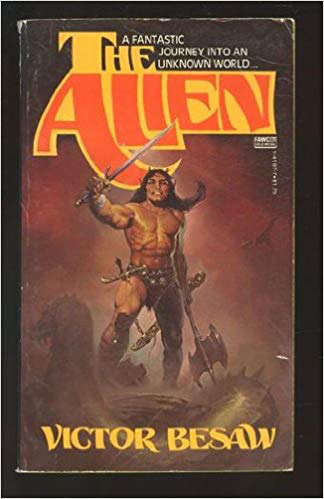Forgotten SF Novels: The Alien
I’ve got floor-to-ceiling bookshelves in two rooms that are crammed with old SF novels. Every once in a while one of them catches my eye, and I give it a re-read. Some are old friends that deserve the attention, while others are basking in well-deserved obscurity.
First up is one that I read back in the late Seventies, after I’d just heard about a new movie called “Alien”. Since I wasn’t really in a position to go see it in a theater, I popped into the local library to try to find a novelization and see what it was about.
They didn’t have it. Instead, I found something called The Alien, and the cover made it pretty clear that there weren’t going to be any spaceships.

I don’t remember when or where I actually bought a copy, but it was almost certainly out of the same misplaced nostalgia that led me to hunt down a copy of Manly Banister’s Conquest Of Earth (aka The Scarlet Saint), another dusty old library classic.
The Alien was the second, and last, novel by one Victor Besaw, published in paperback by Fawcett in 1979. The Internet doesn’t seem to know a damn thing about him, but I’m inclined to say he lacked the Gift of Names:
“Outside Gelsan on the road to Malkha Voet,
on the third day of the year of Lilkhanflet
Bdengi got himself a strange new thrall…
a small Nyarlethu, scarce five mangi tall.”
That’s how it starts, and before the brief prologue is over, we’ve heard about the Vilarian sun, the Chalkhrondu, the Volsek river, a carriage pulled by delkhators, Bdengi’s wife Verla (who calls him Zhen), some sort of divinity to swear by named Khanophet, his driver Haldor (who calls him vlan), his guard Arlo, and Our Hero himself, the toddler Godranec, fed a nice piece of roasted tharg by Verla after being dropped in the middle of the road by a skaldu bird.
And that’s just the first three pages. I’ve gotten more consistent names out of a pile of Boggle dice. The world-building is just as consistent, which is to say not at all. Every few pages, something happens that introduces a half-dozen more boggle-words, another strange race, and a minor challenge for Our Hero to overcome. It makes for a rather quick read, and it isn’t a long book to begin with.
When he’s fully grown and conveniently armed with a magic spear (given to him by his master to destroy in the forge), a noble’s sword (given to him by the Halzhengim lizard-men, along with some advice from their tribe’s shogan on how to find his people), and a mighty axe (made by Our Hero in his master’s forge, which he conveniently had to himself that night), he murders the kitchen overseer Kula (as promised 40 pages earlier) and sets out for his freedom through the mysterious and deadly wierwood.
About a hundred pages later, Our Hero defeats a mighty cave bear, is reunited with his people, learns his true identity, and gains a beautiful princess as his wife, all in about ten pages. The end.
The book is stuffed with Tiny Adventures that are over almost before they start, each involving a new and different and vaguely-sketched element of this fantasy world, with no real thought to fitting them together into a coherent whole. Most disasters are averted by the convenient fact that his horns have a Spidey-sense, alerting him to plot points. It’s like reading an ADHD teen trying to imitate Edgar Rice Burroughs.
These days, it would be a 14-book indie series on Kindle, with each volume over 300 virtual pages long, but Besaw crammed it all into one, and that was that.
Worth reading? Only as a snapshot of the sort of brisk pulp fantasy that fed a hungry young SF market in that era. No sex, no gore, no character development, no world-building, just a nondescript protagonist who overcomes every obstacle in a few paragraphs and gets the girl.
On a related note, Good Show Sir collects terrible SF covers…
Comments via Isso
Markdown formatting and simple HTML accepted.
Sometimes you have to double-click to enter text in the form (interaction between Isso and Bootstrap?). Tab is more reliable.